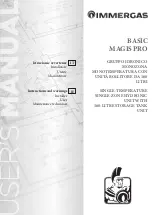
5
Maintenance Procedures
SECTION III - MAINTENANCE PROCEDURES
The CHALLENGER must be inspected and serviced
annually, preferably at the start of the heating sea-
son, by a qualified service technician. In addition,
the maintenance and care of the appliance as out-
lined on page 4 and further explained on pages 5
through 7 must be performed to assure maximum
efficiency and reliability of the appliance. Failure to
service and maintain the CHALLENGER and the sys-
tem components could result in equipment failure,
causing possible severe personal injury, death or
substantial property damage.
The following information provides detailed instruc-
tion for completing the maintenance items outlined
in the maintenance schedule on page 4. In addition
to this maintenance, the CHALLENGER should be
serviced at the beginning of the heating season by a
qualified service technician.
Periodic Maintenance
Check the Surrounding Area
To prevent potential of severe personal injury, death
or substantial property damage, eliminate all the
materials listed on page 3 from the area surrounding
the appliance and from the vicinity of the combus-
tion air inlet. If contaminates are found:
Remove products immediately from the area. If they
have been there for an extended period, call a quali-
fied service technician to inspect the appliance for
possible damage from acid corrosion.
If products cannot be removed, immediately call a
qualified service technician to re-pipe the combus-
tion air inlet piping and locate the combustion air
intake away from the contaminated areas.
WARNING
WARNING
NOTICE
1. Combustible / flammable materials - Do not
store combustible materials, gasoline or other
flammable vapors or liquids near the appliance.
Remove immediately if found.
2. Air contaminates - Products containing chlorine
or fluorine, if allowed to contaminate the com-
bustion air, will cause acidic condensate within
the appliance. This will cause significant dam-
age to the appliance. Read the list of potential
materials listed on page 3 of this manual. If any
of these products are in the room from which the
appliance takes its combustion air, they must be
removed immediately or the combustion air
intake must be relocated to another area.
Check Combustion Air Inlets
1. Verify that ventilation air openings to the
mechanical room are open and unobstructed.
2. Verify that the appliance’s vent termination and
combustion air intake are clean and free of
obstructions. Remove any debris on the air
intake or flue exhaust openings. If removing the
debris does not allow the appliance to operate
correctly, contact your qualified service techni-
cian to inspect the appliance and the vent / com-
bustion air system.
Check Temperature Display and Pressure Gauge
1. Ensure the pressure reading on the pressure
gauge does not exceed 25 psig [1.7 bar].
Higher pressure readings may indicate a prob-
lem with the expansion tank.
2. Ensure the temperature on the display panel
does not exceed 194
º
F [90ºC]. Higher tempera-
ture readings may indicate a problem with the
operating thermostat controls.
3. Contact a qualified service technician if prob-
lem persists.
Monthly Maintenance
Check Vent Piping
1. Visually inspect the entire length of flue gas vent
piping including all joints and appliance adapter
for any signs of blockage, leakage or deteriora-
tion of gaskets or piping. Notify a qualified serv-
ice technician immediately if any problems are
found.









































